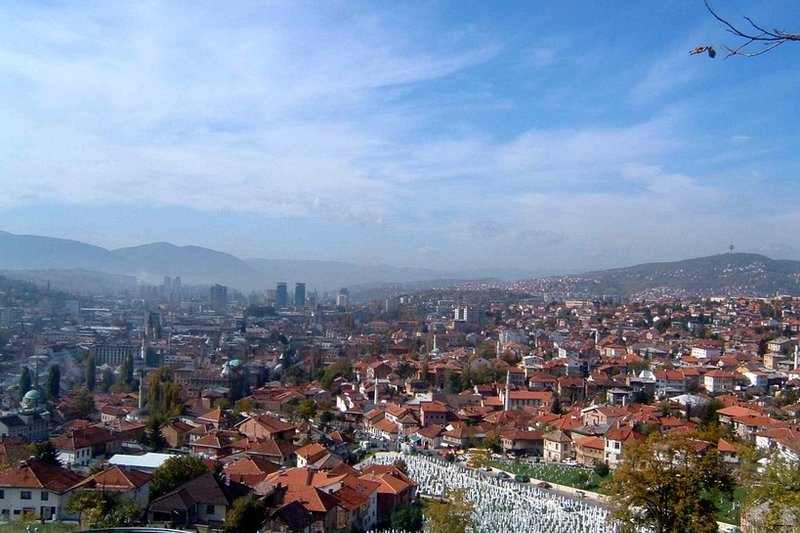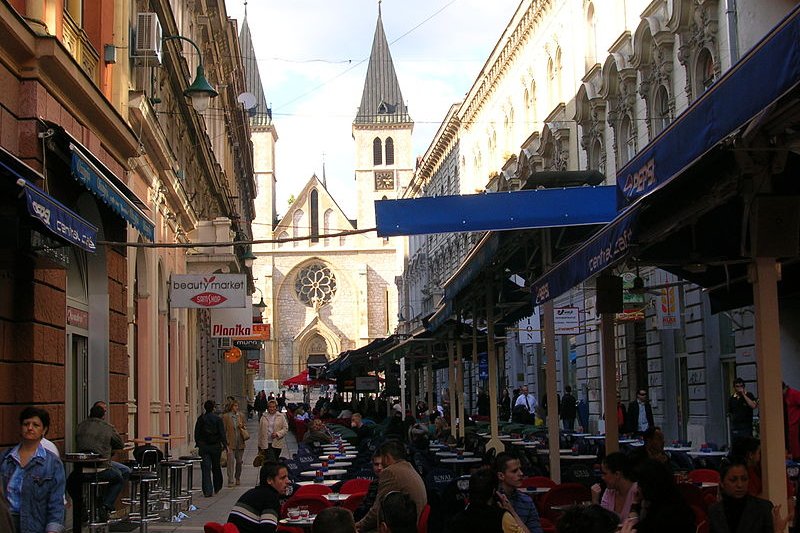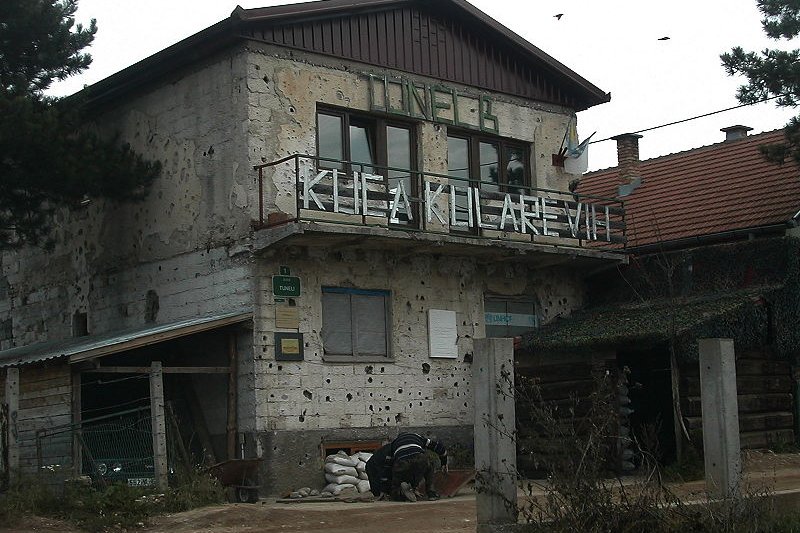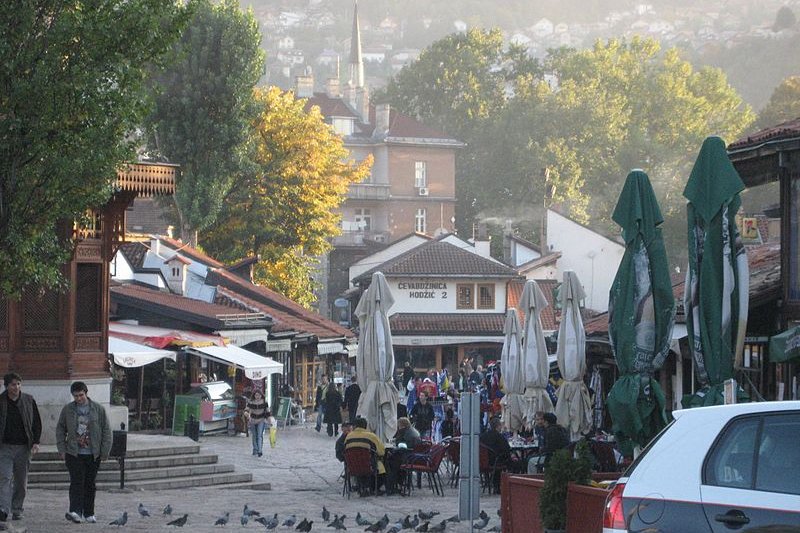
Sarajevo, Bosnia & Herzegovina
 Go Back - HOME | Latest Bosnia Herzegovina > Europe > World | YouTube : Facebook | About Me : Contact Me
Go Back - HOME | Latest Bosnia Herzegovina > Europe > World | YouTube : Facebook | About Me : Contact Me Sarajevo, Bosnia and Herzegovina
Sarajevo, Bosnia and HerzegovinaSource: https://commons.wikimedia.org/wiki/File:Sarajevoview.PNG
Author: A friend of Asim Led, WeFt

Sarajevo (GPS: 43.85186, 18.39454) is the capital and biggest city in Bosnia and Herzegovina. Many people associate it with the Bosnian War, but Sarajevo is today a peaceful city that is receiving an increasing stream of visitors. The city covers 141.5 sq km (54.6 sq mi) and has a population of 311,000 (2011 estimate), within a metropolitan area of 437,000 people. The city is within the Sarajevo Canton, which covers 1,276.9 sq km (493 sq mi).
Sarajevo is in the Central European Time, which is an hour ahead of Coordinated Universal Time (UTC+1). Its phone area code is +387 (33). It is within the Sarajevo Valley, in the Dinaric Alps, near the heart of the country. The city is surrounded by a number of tall mountains including Treskavica (2,088 m / 6,850 ft), Bjelašnica (2,067 m / 6,781 ft), Jahorina (1,913 m / 6,276 ft), Trebević (1,627 m / 5,338 ft) and igman (1,502 m / 4,928 ft). Flowing through the city center is the Miljacka River, also called the Sarajevo River. It meets the Bosna River on the western part of the city.
Sarajevo is divided into four major districts namely Centar (Central), Novi Grad (New Town), Novo Sarajevo (New Sarajevo) and Stari Grad (Old Town). The city experiences a continental climate. The warmest months here are July and August, when the average high temperature reaches 25.5°C (77.9°F) or more. Coldest month is January, when the average low temperature drops to -4.4°C (24.1°F). The wettest month is June, which receives 91 mm (3.583 in) of precipitation.
The Sarajevo area has been inhabited since Neolithic times. The Butmir culture, discovered in 1893, is a Neolithic culture from 2,600 BC - 2,400 BC. It was discovered in Butmir, within the Sarajevo Canton. The next civilization to appear in Sarajevo area were the Illyrians, around the 4th century BC. Then came the Romans in 9 AD, then the Goths and the Slavs in the 7th century.
 Strosmejerova Street in Saravejo, with Saravejo Cathedral in the background
Strosmejerova Street in Saravejo, with Saravejo Cathedral in the backgroundSource: https://commons.wikimedia.org/wiki/File:Strosmajerova_street,_Sarajevo.jpg
Author: Damien Smith

Sarajevo was founded during Ottoman rule of Bosnia, around 1461, when a collection of small villages were merged into a city. By 1660 it had grown to become the biggest Ottoman city in the Balkans, with a population of 80,000, compared to Belgrade's population of 12,963 in 1838.
However, in 1699 Sarajevo was razed by the army of Prince Eugene of Savoy of the Habsburg Monarchy against the Ottoman Empire. He destroyed much of the city. By 1807, Sarajevo's population was down to 60,000.
Sarajevo became part of the Austro-Hungarian Empire in 1878, and was made part of Austria-Hungary in 1908. On 28 June, 1914, Archduke Ferdinand of Austria was assassinated at the Latin Bridge in Sarajevo by Bosnian Serb assassins. This sparked the First World War, which ironically spared Sarajevo much of the destruction, as most of the fighting occured in Belgrade.
The Balkans were united under the Kingdom of Yugoslavia after the war, and Sarajevo became the capital of Drina Province. During the Second World War, it became part of the Independent State of Croatia. It was occupied by the Nazis from 1941 until 1945. Sarajevo then became the capital of the Socialist Republic of Bosnia and Herzegovina, a component of the Socialist Federal Republic of Yugoslavia. It hosted the 1984 Winter Olympics, which did much in boosting tourism to the city.
The collapse of the Soviet Union brought with it the Bosnian war and the Siege of Sarajevo from 1992 to 1995, which had a civilian casualty numbering 10,000 people, including 1,500 children. During the siege, the people of Sarajevo built the 960-meter (3,150 ft) Sarajevo Tunnel to link it with the Bosnian-held territory on the neutral area controlled by the United Nations.
 Sarajevo Tunnel entrance, now the Sarajevo Tunnel Museum
Sarajevo Tunnel entrance, now the Sarajevo Tunnel MuseumSource: https://commons.wikimedia.org/wiki/File:Sarajevo_tunnel_museum.jpg
Author: Baumi

The city of Sarajevo is today at peace and is gradually healing the wounds of its war years. Remnants of shelled buildings can still be seen within Sarajevo, as the city built itself around them.
Visiting Sarajevo, Bosnia & Herzegovina
The Sarajevo Airport (SJJ) is the gateway to Sarajevo. It is located in Butmir, about 6.1 km to the southwest of the city center. Airport shuttle bus 200E connects the airport to the city center. Alternatively, public bus 36 goes to Neděarići, where you can transfer to a city tram that goes to the city center. Baščaršija marketplace in Sarajevo
Baščaršija marketplace in SarajevoSource: https://commons.wikimedia.org/wiki/File:Sarajevo-bascarsija1.JPG
Author: Modzzak

Exploring Sarajevo
The Old Town part of Sarajevo is best explored on foot. For greater distances, there is a spinal tram service which makes a counter clockwise loop around the central district. Tickets can be purchased at kiosks marked "tisak". A day-pass is available for 5KM, allowing unlimited rides on the public transports, including the buses and trolleybuses.Places of Interest in Sarajevo, Bosnia & Herzegovina
- Archangel Michael and Gabriel Orthodox Church and Museum
- Ashkenazi Synagogue
- Emperor's Mosque
- Franciscan Church of St Anthony
- Gazi Husrev Bey Mosque
- History Museum
- Latin Bridge
- Long Bazaar and Brusa Bazaar
- Markale Market Place
- Morica Han
- National Art Gallery
- National Library
- Old Synagogue and Jewish Museum
- Old Town
- Sebilj
- Vijecnica
- Vrelo Bosne
- Yellow Fortress
 Latest updates on Penang Travel Tips
Latest updates on Penang Travel Tips

Copyright © 2003-2025 Timothy Tye. All Rights Reserved.